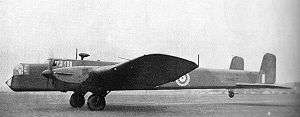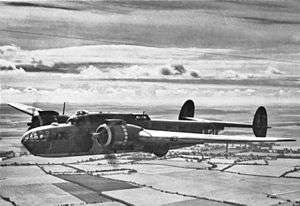No. 296 Squadron RAF
| No. 296 Squadron RAF | |
|---|---|
| Active | 25 January 1942 – 23 January 1946 |
| Country |
|
| Branch |
|
| Role | Airborne forces and Transport |
| Part of | No. 38 Group RAF[1] |
| Motto(s) | Prepared for all things[2][3] |
| Engagements | Sicily, Normandy, Arnhem |
| Insignia | |
| Squadron Badge heraldry | In front of a sword in pale, the point downwards, a scroll[2][3] |
| Squadron Codes |
XH (Aug 1942 – Nov 1943)[4][5] 9W (Oct 1943 – Jan 1946)[6][7] 7C (Mar 1944 – Jan 1946)[8][9] |
No. 296 Squadron RAF was an airborne forces squadron of the Royal Air Force during World War II. With sister squadrons 295 and 297 it formed 38 Wing, which later expanded to create No. 38 Group RAF.[1]
History
With the Airborne Forces

No. 296 Squadron was formed at Ringway Airport near Manchester on 25 January 1942 from the Glider Exercise Unit as an airborne forces unit, equipped with obsolete Hawker Hectors and Hawker Harts, and moved to RAF Netheravon to concentrate on glider training. In June 1942 it began to receive the Armstrong Whitworth Whitley and in October 1942 began flying leaflet dropping missions over France. In early 1943 the squadron converted to the Albemarle Mk.I and in Summer 1943 moved 32 aircraft to Froha, Algeria to take part in Operation Husky, the invasion of Sicily, returning later in the year.

The Squadron was involved in the first part of the D-Day landings. On the night of 5/6 June 1944, as part of Operation Tonga, three Albemarles flew Pathfinder parachutists to Normandy followed by eight more loaded with paratroops of 5th Parachute Brigade. During 6 June the squadron returned with a further eight towing Horsa gliders. For Operation Mallard which immediately followed, 296 squadron despatched 19 aircraft towing gliders to Normandy. Other missions involved dropping SAS sabotage teams behind enemy lines. The Albemarle's last major mission came during the battle of Arnhem, where the squadron towed across forty-six gliders in two waves from Manston aerodrome without loss in the first two days of the battle. The Albemarles gave way in September 1944 to the Handley Page Halifax of which 30 were provided for Operation Varsity, the Rhine crossings. At the end of the war the squadron was used to ferry troops to Norway and Denmark to take the German surrender and to bring liberated POWs back to Britain.
With Transport Command
The squadron operated a mail service to India from December 1945 until it disbanded on 23 January 1946 at RAF Earls Colne, Essex.
Aircraft operated
| From | To | Aircraft | Version |
|---|---|---|---|
| January 1942 | August 1942 | Hawker Hector | Mk.1 |
| January 1942 | August 1942 | Hawker Hart | |
| June 1942 | March 1943 | Armstrong Whitworth Whitley | Mk.V |
| January 1943 | November 1944 | Armstrong Whitworth Albemarle | Mks.I, II |
| September 1944 | November 1944 | Armstrong Whitworth Albemarle | Mks.IV, V |
| September 1944 | Mar 1945 | Handley Page Halifax | Mk.V |
| February 1945 | January 1946 | Handley Page Halifax | Mk.III |
| December 1945 | January 1946 | Handley Page Halifax | A.7 |
Squadron bases
| From | To | Base | Remark |
|---|---|---|---|
| 25 January 1942 | 1 February 1942 | RAF Ringway, Cheshire | Formed here |
| 1 February 1942 | 25 July 1942 | RAF Netheravon, Wiltshire | Det. at RAF Hurn, Dorset |
| 25 July 1942 | 25 October 1942 | RAF Hurn, Dorset | |
| 25 October 1942 | 19 December 1942 | RAF Andover, Hampshire | |
| 19 December 1942 | 25 June 1943 | RAF Hurn, Dorset | |
| 3 June 1943 | 15 October 1943 | RAF Stoney Cross, Hampshire | Ground echelon |
| 3 June 1943 | 24 June 1943 | Froha, Algeria | Air echelon |
| 24 June 1943 | 15 October 1943 | Goubrine II, Tunisia | Air echelon. Dets. at Cassibile, Sicily and Torrente Comunelli Airfield, Sicily |
| 15 October 1943 | 14 March 1944 | RAF Hurn, Dorset | Det. at RAF Ayr, Ayrshire, Scotland |
| 14 March 1944 | 29 September 1944 | RAF Brize Norton, Oxfordshire | |
| 29 September 1944 | 23 January 1946 | RAF Earls Colne, Essex | Disbanded here |
Commanding officers
| From | To | Name |
|---|---|---|
| January 1942 | October 1942 | S/Ldr. P.B.N. Davis |
| October 1942 | July 1943 | W/Cdr. P.R. May, AFC |
| July 1943 | August 1943 | W/Cdr. L.C. Bartram |
| August 1943 | October 1944 | W/Cdr. D.I. McInnies |
| October 1944 | February 1945 | S/Ldr. R.W. Jamieson |
| February 1945 | January 1946 | W/Cdr. T.C. Musgrave |
See also
References
Notes
- 1 2 Delve 1994, p. 65.
- 1 2 Rawlings 1982, p. 194.
- 1 2 3 4 Halley 1988, p. 352.
- ↑ Bowyer and Rawlings 1979, p. 114.
- ↑ Flintham and Thomas 2003, p. 120.
- ↑ Bowyer and Rawlings 1979, p. 113.
- ↑ Flintham and Thomas 2003, p. 61.
- ↑ Bowyer and Rawlings 1979, p. 28.
- ↑ Flintham and Thomas 2003, p. 60.
- 1 2 3 Rawlings 1982, p. 195.
- 1 2 Jefford2001, p. 86.
Bibliography
- Bowyer, Michael J.F. and John D.R. Rawlings. Squadron Codes, 1937–56. Cambridge, UK: Patrick Stephens, 1979. ISBN 0-85059-364-6.
- Delve, Ken. The Source Book of the RAF. Shrewsbury, Shropshire, UK: Airlife Publishing, 1994. ISBN 1-85310-451-5.
- Flintham, Vic and Andrew Thomas. Combat Codes: A full explanation and listing of British, Commonwealth and Allied air force unit codes since 1938. Shrewsbury, Shropshire, UK: Airlife Publishing, 2003. ISBN 1-84037-281-8.
- Halley, James J. The Squadrons of the Royal Air Force & Commonwealth 1918–1988. Tonbridge, Kent, UK: Air Britain (Historians), 1988. ISBN 0-85130-164-9.
- Jefford, Wing Commander C.G., MBE, BA, RAF(Retd.). RAF Squadrons, a Comprehensive record of the Movement and Equipment of all RAF Squadrons and their Antecedents since 1912. Shrewsbury, Shropshire, UK: Airlife Publishing, 1988 (second edition 2001). ISBN 1-85310-053-6.
- Rawlings, John D.R. Coastal, Support and Special Squadrons of the RAF and their Aircraft. London: Jane's Publishing Company, 1982. ISBN 0-7106-0187-5.
External links
| Wikimedia Commons has media related to No. 296 Squadron RAF. |
- 296 Squadron
- Site with pages for all squadron of No. 38 Group RAF
- Squadron history on MOD site
- squadron histories nos. 296–299 on RAFWeb's Air of Authority – A History of RAF Organisation
